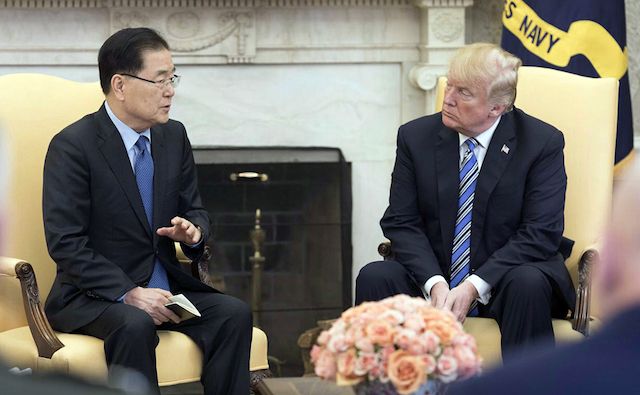What to expect of North Korea?
Faced with an assertive U.S. military and diplomatic response to his latest tests of nuclear weapons systems, the North Korean ruler has changed his tack. Kim Jong-un now says he is ready to give up his nuclear deterrence and make peace with South Korea.

In a nutshell
- North Korea is not isolated in the world. There are other stakeholders in Kim Jong-un’s latest geopolitical game
- In theory, the ruling communist clan could trade its nuclear deterrence for recognition and economic gains
- A detente and transition to more lenient forms of governance in North Korea, however, could put the Kims at risk internally
Kim Jong-un, the North Korean ruler of the communist Kim dynasty, followed in the footsteps of his father and grandfather as an unorthodox leader. As he repeatedly tested his nuclear war material and threatened South Korea, Japan and the United States with potential missile attacks, many considered him a nutcase. It was hard to understand the man’s rationale for these provocations.
However, Mr. Kim is not crazy. He followed his own logic – terrible and cruel, but logic nonetheless.
The main objective is to maintain power. Mr. Kim needs an effective deterrent – which nuclear capabilities represent – to keep foreign powers from intervening in his country. Furthermore, he can maintain his repressive regime internally only by showing himself as strong and successful to his people.
But North Korea is not isolated in the world. There are other stakeholders in this dangerous game.
First is South Korea, the neighbor to the south, which is in theory still at war with North Korea. It has been threatened by the North’s strong army, its artillery positioned along the border within easy range of Seoul, and, more recently, its nuclear capacity.
The Kim dynasty is the linchpin of the system that prevents the Koreas’ reunification.
China is the second most interested party. It sees itself as the hegemon of the region and considers North Korea to be within its sphere of influence. A Korean reunification would pose geopolitical problems for Beijing, as it would strengthen the U.S.-led alliance system in the region and bring American influence right up to the Chinese border. Russia has a similar problem, as its border with North Korea runs less than 100 kilometers from Vladivostok, its main Pacific port. The Kim dynasty is the linchpin of the system that prevents the Koreas’ reunification. That is why China wants to keep the Kim dynasty in place, even though it is not fond of the present leader, Kim Jong-un.
North Korea’s development of nuclear capacities has reached the point of posing a direct threat to Japan, and the U.S. may come next. Washington is obligated to protect its allies, Japan and South Korea, and it will in no case tolerate the North Korean threat to its mainland.
U.S. President Donald Trump responded to Mr. Kim’s nuclear test in an assertive way, placing the state-of-the art THAAD anti-ballistic missile system in South Korea and ordering a concentration of U.S. naval and air assets near the Korean Peninsula. Washington also encouraged Japan and South Korea to show strength. The military threat was credible enough to discourage Mr. Kim.
Sudden change
And next, the world learned that the North Korean ruler and President Trump have agreed to meet. For Mr. Kim, such a summit had been a long-sought goal as it would showcase his own importance. Mr. Trump’s precondition for playing along is Mr. Kim’s full commitment to the denuclearization of North Korea.
This move started a diplomatic chain reaction. The North Korean leader went to Beijing and presumably learned how far the Chinese are willing to let him go in negotiations with the U.S. Another result was a summit of the leaders of the two Koreas. The meeting with President Trump is pending.
The new situation may necessitate a paradigm change for Seoul: recognizing the sovereignty of North Korea could be one of the results. In the view of South Korea, there is just one Korea in existence. This new development stabilizes the region, making a military attack by the North unlikely. A “Korean solution” is popular in the South and has given the left-wing government in Seoul a shot in the arm.
As a rising hegemon in Asia, China is groping for a solution under which North Korea’s sovereignty could be guaranteed in a theoretical fashion, while in fact the country would be vassalized to China. With Mr. Kim remaining as a figurehead, China would push for a new variety of the old “one country, two systems” scheme in the North Korea-China relationship.
For the U.S. and Japan, all this brings about a welcome de-escalation in a very dangerous area. It is also a diplomatic triumph for President Trump. We may have a win-win situation for everybody – with a possible exception of Moscow, which has been happy to watch the Korean crisis bolster pro-U.S. forces in the Far East.
What is still not clear is Mr. Kim’s agenda. He has made a big international splash and is now in a position to barter his nuclear weapons for recognition and, probably, meaningful economic concessions. But he also must be aware that any transition from North Korea’s current, extremely repressive system to more lenient forms of governance could be risky to his regime.
An abrupt demise of the former ruling elite and members of the Kim clan could easily take place. For this reason alone, one should still expect surprises. Mr. Kim’s full agenda is difficult to assess.
